Impact of Disability Models on Autism Perceptions: A Critical Analysis
VerifiedAdded on 2022/10/04
|11
|3133
|18
Essay
AI Summary
This essay provides a comprehensive analysis of the medical and social models of disability and their impacts on the perception of autism. It begins by defining and contrasting the two models, highlighting the medical model's focus on disability as a disease and the social model's emphasis on societal barriers. The essay then explores how these models influence family, social, and cultural perceptions of autism, including the stress experienced by parents, the influence of cultural beliefs on treatment choices, and the role of social factors in shaping understanding of autism. It further discusses the contribution of family perception to the choice of disability model used in managing autism, noting the impact of parental education, family income, and autism symptoms. The essay concludes by emphasizing the importance of considering cultural factors and social perceptions in understanding and addressing autism, highlighting the need for a holistic approach that acknowledges the diverse perspectives and experiences of individuals and families affected by autism.
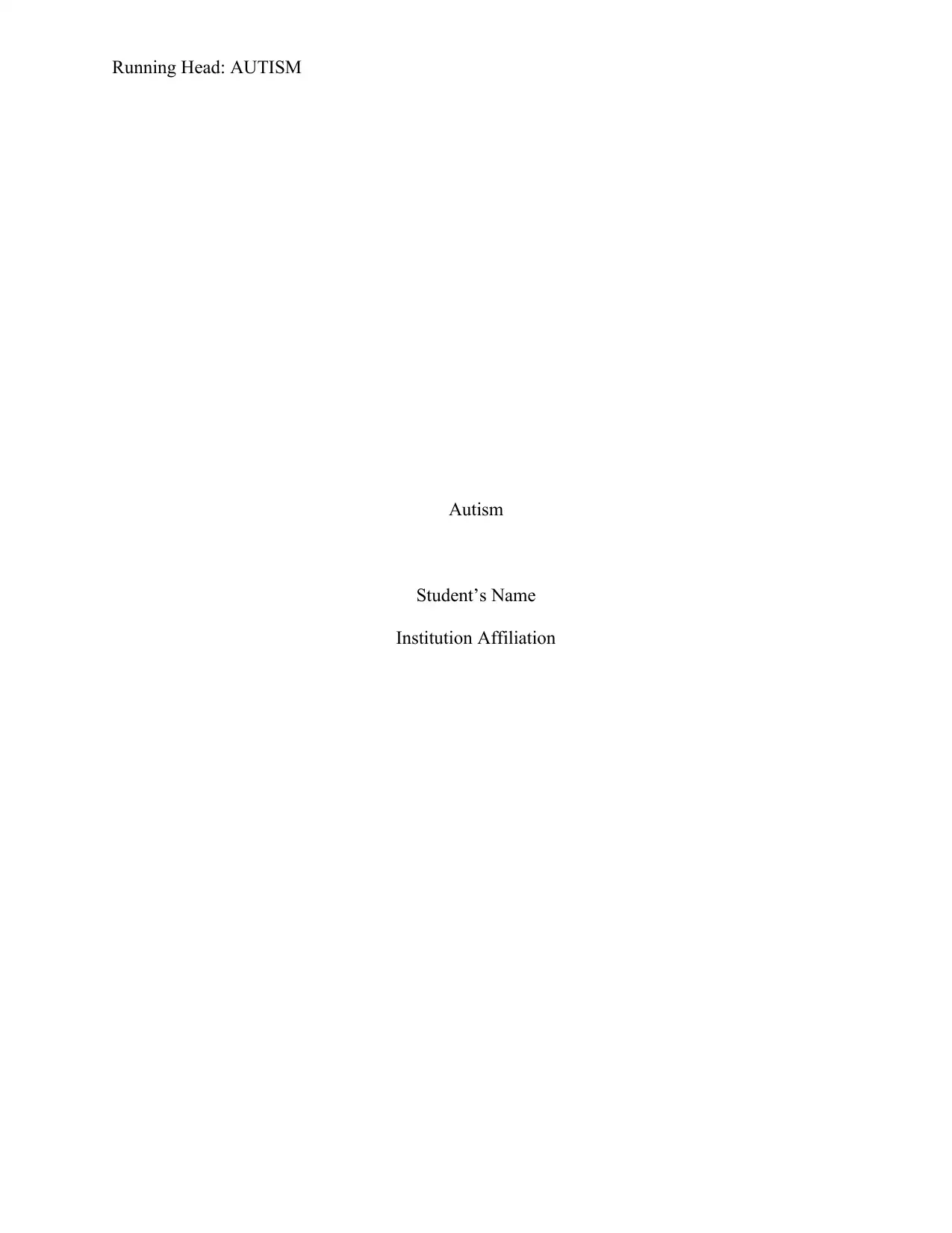
Running Head: AUTISM
Autism
Student’s Name
Institution Affiliation
Autism
Student’s Name
Institution Affiliation
Paraphrase This Document
Need a fresh take? Get an instant paraphrase of this document with our AI Paraphraser
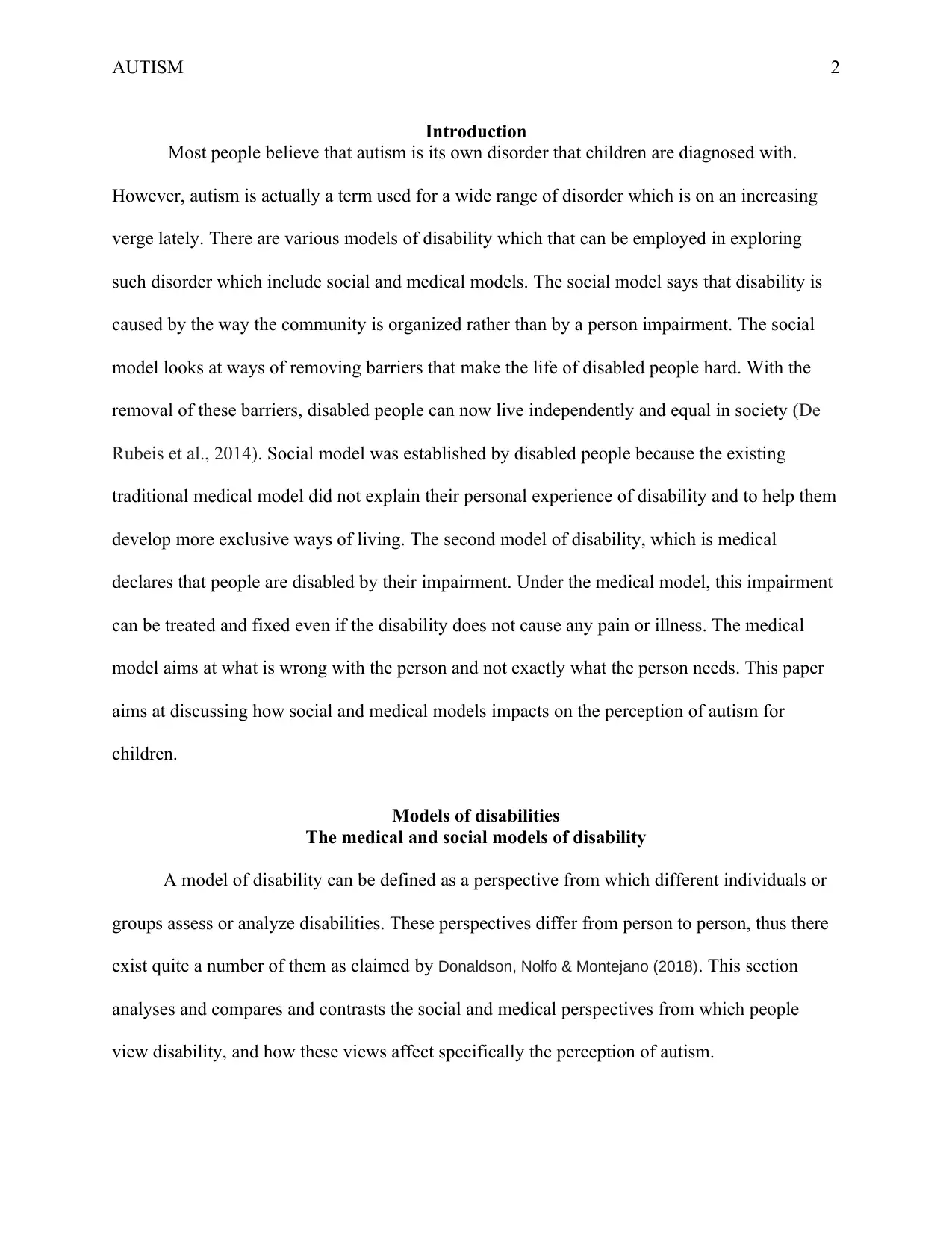
AUTISM 2
Introduction
Most people believe that autism is its own disorder that children are diagnosed with.
However, autism is actually a term used for a wide range of disorder which is on an increasing
verge lately. There are various models of disability which that can be employed in exploring
such disorder which include social and medical models. The social model says that disability is
caused by the way the community is organized rather than by a person impairment. The social
model looks at ways of removing barriers that make the life of disabled people hard. With the
removal of these barriers, disabled people can now live independently and equal in society (De
Rubeis et al., 2014). Social model was established by disabled people because the existing
traditional medical model did not explain their personal experience of disability and to help them
develop more exclusive ways of living. The second model of disability, which is medical
declares that people are disabled by their impairment. Under the medical model, this impairment
can be treated and fixed even if the disability does not cause any pain or illness. The medical
model aims at what is wrong with the person and not exactly what the person needs. This paper
aims at discussing how social and medical models impacts on the perception of autism for
children.
Models of disabilities
The medical and social models of disability
A model of disability can be defined as a perspective from which different individuals or
groups assess or analyze disabilities. These perspectives differ from person to person, thus there
exist quite a number of them as claimed by Donaldson, Nolfo & Montejano (2018). This section
analyses and compares and contrasts the social and medical perspectives from which people
view disability, and how these views affect specifically the perception of autism.
Introduction
Most people believe that autism is its own disorder that children are diagnosed with.
However, autism is actually a term used for a wide range of disorder which is on an increasing
verge lately. There are various models of disability which that can be employed in exploring
such disorder which include social and medical models. The social model says that disability is
caused by the way the community is organized rather than by a person impairment. The social
model looks at ways of removing barriers that make the life of disabled people hard. With the
removal of these barriers, disabled people can now live independently and equal in society (De
Rubeis et al., 2014). Social model was established by disabled people because the existing
traditional medical model did not explain their personal experience of disability and to help them
develop more exclusive ways of living. The second model of disability, which is medical
declares that people are disabled by their impairment. Under the medical model, this impairment
can be treated and fixed even if the disability does not cause any pain or illness. The medical
model aims at what is wrong with the person and not exactly what the person needs. This paper
aims at discussing how social and medical models impacts on the perception of autism for
children.
Models of disabilities
The medical and social models of disability
A model of disability can be defined as a perspective from which different individuals or
groups assess or analyze disabilities. These perspectives differ from person to person, thus there
exist quite a number of them as claimed by Donaldson, Nolfo & Montejano (2018). This section
analyses and compares and contrasts the social and medical perspectives from which people
view disability, and how these views affect specifically the perception of autism.
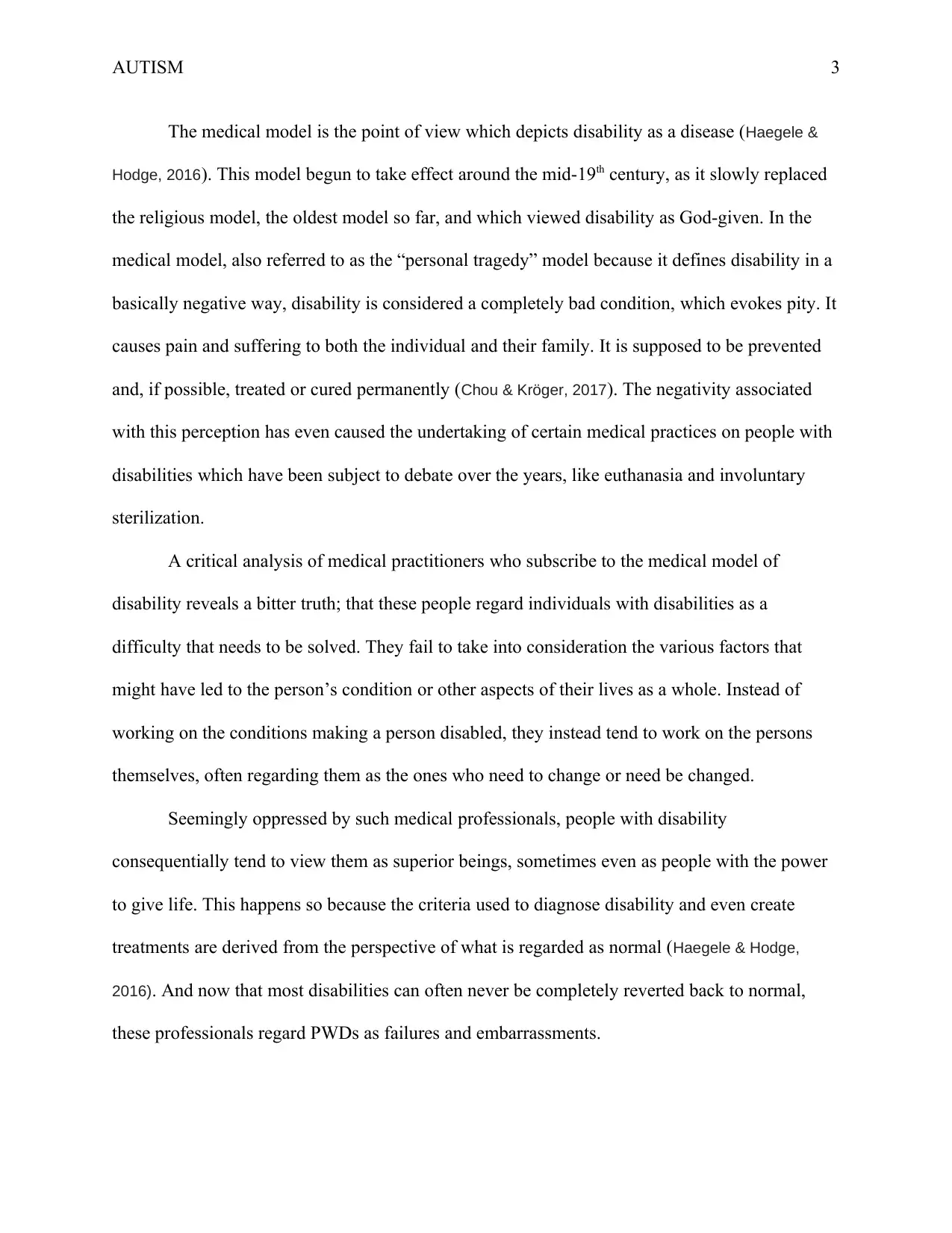
AUTISM 3
The medical model is the point of view which depicts disability as a disease (Haegele &
Hodge, 2016). This model begun to take effect around the mid-19th century, as it slowly replaced
the religious model, the oldest model so far, and which viewed disability as God-given. In the
medical model, also referred to as the “personal tragedy” model because it defines disability in a
basically negative way, disability is considered a completely bad condition, which evokes pity. It
causes pain and suffering to both the individual and their family. It is supposed to be prevented
and, if possible, treated or cured permanently (Chou & Kröger, 2017). The negativity associated
with this perception has even caused the undertaking of certain medical practices on people with
disabilities which have been subject to debate over the years, like euthanasia and involuntary
sterilization.
A critical analysis of medical practitioners who subscribe to the medical model of
disability reveals a bitter truth; that these people regard individuals with disabilities as a
difficulty that needs to be solved. They fail to take into consideration the various factors that
might have led to the person’s condition or other aspects of their lives as a whole. Instead of
working on the conditions making a person disabled, they instead tend to work on the persons
themselves, often regarding them as the ones who need to change or need be changed.
Seemingly oppressed by such medical professionals, people with disability
consequentially tend to view them as superior beings, sometimes even as people with the power
to give life. This happens so because the criteria used to diagnose disability and even create
treatments are derived from the perspective of what is regarded as normal (Haegele & Hodge,
2016). And now that most disabilities can often never be completely reverted back to normal,
these professionals regard PWDs as failures and embarrassments.
The medical model is the point of view which depicts disability as a disease (Haegele &
Hodge, 2016). This model begun to take effect around the mid-19th century, as it slowly replaced
the religious model, the oldest model so far, and which viewed disability as God-given. In the
medical model, also referred to as the “personal tragedy” model because it defines disability in a
basically negative way, disability is considered a completely bad condition, which evokes pity. It
causes pain and suffering to both the individual and their family. It is supposed to be prevented
and, if possible, treated or cured permanently (Chou & Kröger, 2017). The negativity associated
with this perception has even caused the undertaking of certain medical practices on people with
disabilities which have been subject to debate over the years, like euthanasia and involuntary
sterilization.
A critical analysis of medical practitioners who subscribe to the medical model of
disability reveals a bitter truth; that these people regard individuals with disabilities as a
difficulty that needs to be solved. They fail to take into consideration the various factors that
might have led to the person’s condition or other aspects of their lives as a whole. Instead of
working on the conditions making a person disabled, they instead tend to work on the persons
themselves, often regarding them as the ones who need to change or need be changed.
Seemingly oppressed by such medical professionals, people with disability
consequentially tend to view them as superior beings, sometimes even as people with the power
to give life. This happens so because the criteria used to diagnose disability and even create
treatments are derived from the perspective of what is regarded as normal (Haegele & Hodge,
2016). And now that most disabilities can often never be completely reverted back to normal,
these professionals regard PWDs as failures and embarrassments.
⊘ This is a preview!⊘
Do you want full access?
Subscribe today to unlock all pages.

Trusted by 1+ million students worldwide
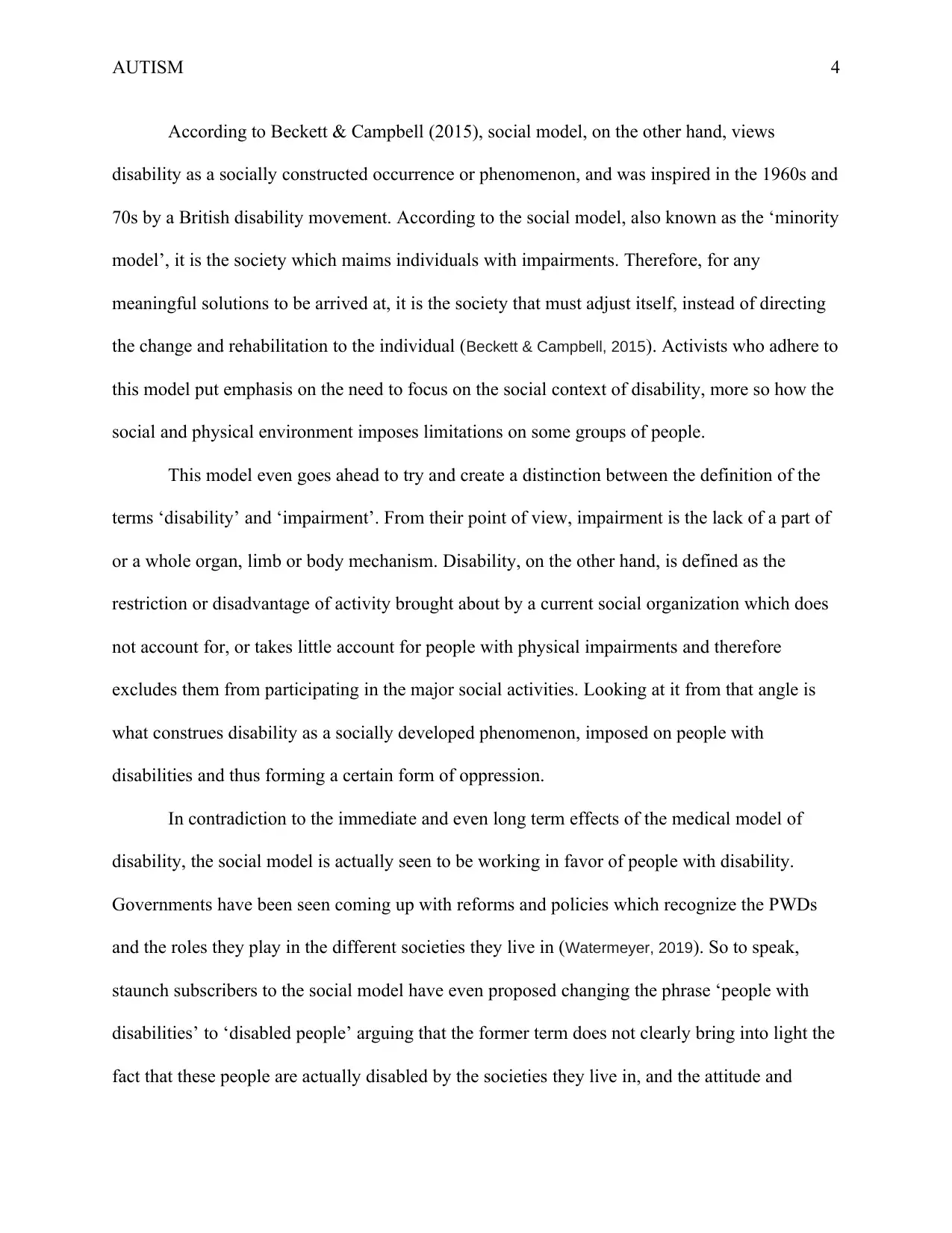
AUTISM 4
According to Beckett & Campbell (2015), social model, on the other hand, views
disability as a socially constructed occurrence or phenomenon, and was inspired in the 1960s and
70s by a British disability movement. According to the social model, also known as the ‘minority
model’, it is the society which maims individuals with impairments. Therefore, for any
meaningful solutions to be arrived at, it is the society that must adjust itself, instead of directing
the change and rehabilitation to the individual (Beckett & Campbell, 2015). Activists who adhere to
this model put emphasis on the need to focus on the social context of disability, more so how the
social and physical environment imposes limitations on some groups of people.
This model even goes ahead to try and create a distinction between the definition of the
terms ‘disability’ and ‘impairment’. From their point of view, impairment is the lack of a part of
or a whole organ, limb or body mechanism. Disability, on the other hand, is defined as the
restriction or disadvantage of activity brought about by a current social organization which does
not account for, or takes little account for people with physical impairments and therefore
excludes them from participating in the major social activities. Looking at it from that angle is
what construes disability as a socially developed phenomenon, imposed on people with
disabilities and thus forming a certain form of oppression.
In contradiction to the immediate and even long term effects of the medical model of
disability, the social model is actually seen to be working in favor of people with disability.
Governments have been seen coming up with reforms and policies which recognize the PWDs
and the roles they play in the different societies they live in (Watermeyer, 2019). So to speak,
staunch subscribers to the social model have even proposed changing the phrase ‘people with
disabilities’ to ‘disabled people’ arguing that the former term does not clearly bring into light the
fact that these people are actually disabled by the societies they live in, and the attitude and
According to Beckett & Campbell (2015), social model, on the other hand, views
disability as a socially constructed occurrence or phenomenon, and was inspired in the 1960s and
70s by a British disability movement. According to the social model, also known as the ‘minority
model’, it is the society which maims individuals with impairments. Therefore, for any
meaningful solutions to be arrived at, it is the society that must adjust itself, instead of directing
the change and rehabilitation to the individual (Beckett & Campbell, 2015). Activists who adhere to
this model put emphasis on the need to focus on the social context of disability, more so how the
social and physical environment imposes limitations on some groups of people.
This model even goes ahead to try and create a distinction between the definition of the
terms ‘disability’ and ‘impairment’. From their point of view, impairment is the lack of a part of
or a whole organ, limb or body mechanism. Disability, on the other hand, is defined as the
restriction or disadvantage of activity brought about by a current social organization which does
not account for, or takes little account for people with physical impairments and therefore
excludes them from participating in the major social activities. Looking at it from that angle is
what construes disability as a socially developed phenomenon, imposed on people with
disabilities and thus forming a certain form of oppression.
In contradiction to the immediate and even long term effects of the medical model of
disability, the social model is actually seen to be working in favor of people with disability.
Governments have been seen coming up with reforms and policies which recognize the PWDs
and the roles they play in the different societies they live in (Watermeyer, 2019). So to speak,
staunch subscribers to the social model have even proposed changing the phrase ‘people with
disabilities’ to ‘disabled people’ arguing that the former term does not clearly bring into light the
fact that these people are actually disabled by the societies they live in, and the attitude and
Paraphrase This Document
Need a fresh take? Get an instant paraphrase of this document with our AI Paraphraser
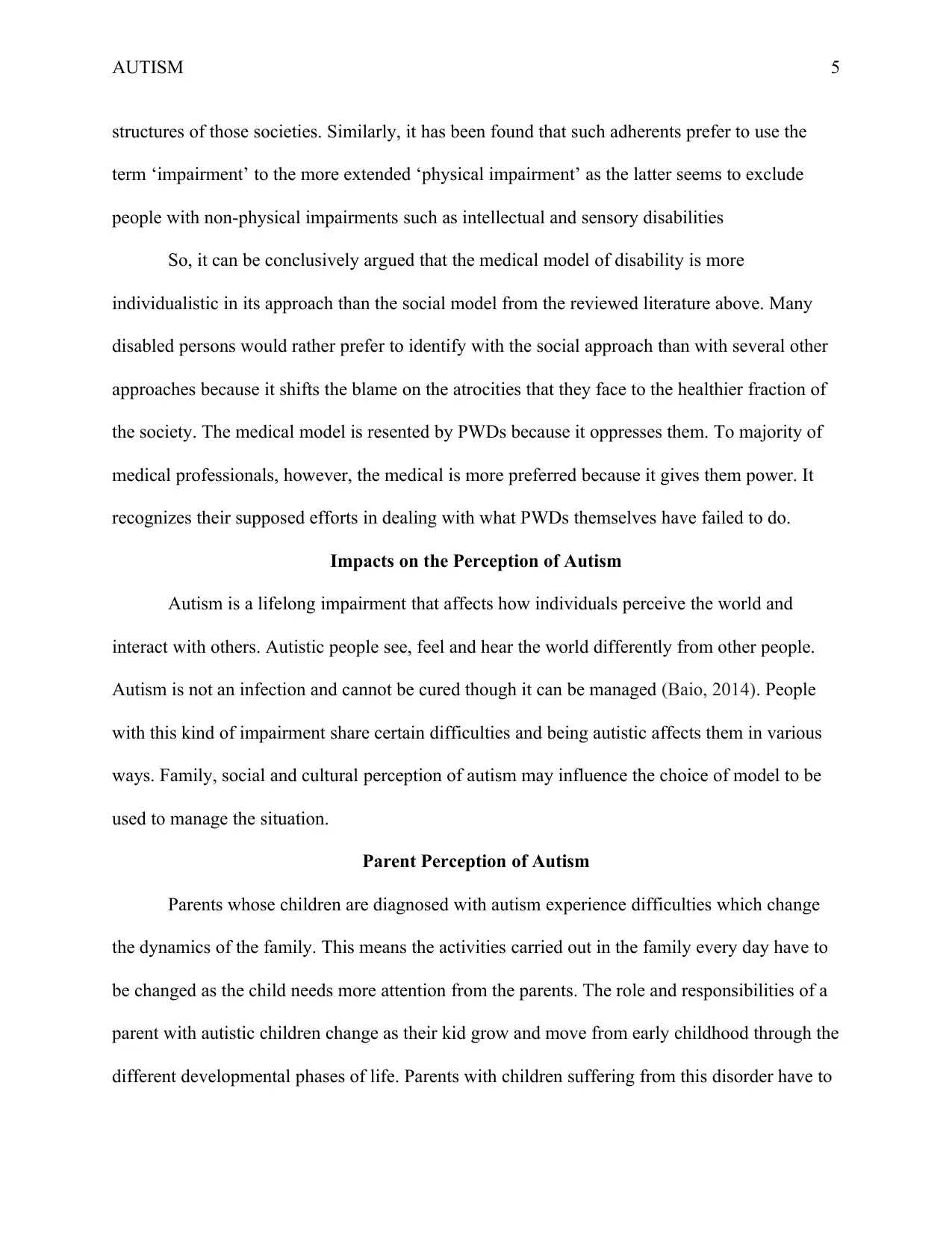
AUTISM 5
structures of those societies. Similarly, it has been found that such adherents prefer to use the
term ‘impairment’ to the more extended ‘physical impairment’ as the latter seems to exclude
people with non-physical impairments such as intellectual and sensory disabilities
So, it can be conclusively argued that the medical model of disability is more
individualistic in its approach than the social model from the reviewed literature above. Many
disabled persons would rather prefer to identify with the social approach than with several other
approaches because it shifts the blame on the atrocities that they face to the healthier fraction of
the society. The medical model is resented by PWDs because it oppresses them. To majority of
medical professionals, however, the medical is more preferred because it gives them power. It
recognizes their supposed efforts in dealing with what PWDs themselves have failed to do.
Impacts on the Perception of Autism
Autism is a lifelong impairment that affects how individuals perceive the world and
interact with others. Autistic people see, feel and hear the world differently from other people.
Autism is not an infection and cannot be cured though it can be managed (Baio, 2014). People
with this kind of impairment share certain difficulties and being autistic affects them in various
ways. Family, social and cultural perception of autism may influence the choice of model to be
used to manage the situation.
Parent Perception of Autism
Parents whose children are diagnosed with autism experience difficulties which change
the dynamics of the family. This means the activities carried out in the family every day have to
be changed as the child needs more attention from the parents. The role and responsibilities of a
parent with autistic children change as their kid grow and move from early childhood through the
different developmental phases of life. Parents with children suffering from this disorder have to
structures of those societies. Similarly, it has been found that such adherents prefer to use the
term ‘impairment’ to the more extended ‘physical impairment’ as the latter seems to exclude
people with non-physical impairments such as intellectual and sensory disabilities
So, it can be conclusively argued that the medical model of disability is more
individualistic in its approach than the social model from the reviewed literature above. Many
disabled persons would rather prefer to identify with the social approach than with several other
approaches because it shifts the blame on the atrocities that they face to the healthier fraction of
the society. The medical model is resented by PWDs because it oppresses them. To majority of
medical professionals, however, the medical is more preferred because it gives them power. It
recognizes their supposed efforts in dealing with what PWDs themselves have failed to do.
Impacts on the Perception of Autism
Autism is a lifelong impairment that affects how individuals perceive the world and
interact with others. Autistic people see, feel and hear the world differently from other people.
Autism is not an infection and cannot be cured though it can be managed (Baio, 2014). People
with this kind of impairment share certain difficulties and being autistic affects them in various
ways. Family, social and cultural perception of autism may influence the choice of model to be
used to manage the situation.
Parent Perception of Autism
Parents whose children are diagnosed with autism experience difficulties which change
the dynamics of the family. This means the activities carried out in the family every day have to
be changed as the child needs more attention from the parents. The role and responsibilities of a
parent with autistic children change as their kid grow and move from early childhood through the
different developmental phases of life. Parents with children suffering from this disorder have to
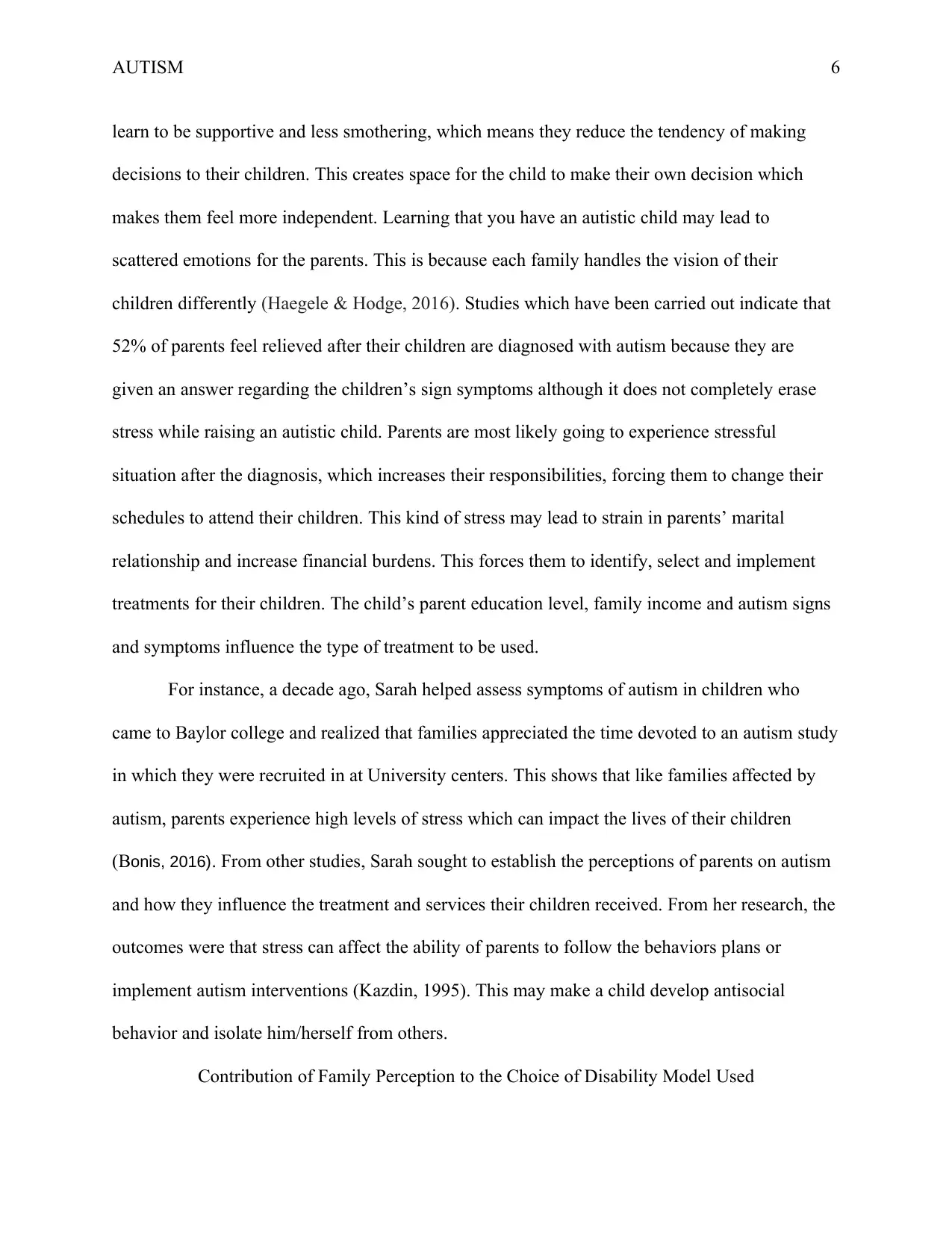
AUTISM 6
learn to be supportive and less smothering, which means they reduce the tendency of making
decisions to their children. This creates space for the child to make their own decision which
makes them feel more independent. Learning that you have an autistic child may lead to
scattered emotions for the parents. This is because each family handles the vision of their
children differently (Haegele & Hodge, 2016). Studies which have been carried out indicate that
52% of parents feel relieved after their children are diagnosed with autism because they are
given an answer regarding the children’s sign symptoms although it does not completely erase
stress while raising an autistic child. Parents are most likely going to experience stressful
situation after the diagnosis, which increases their responsibilities, forcing them to change their
schedules to attend their children. This kind of stress may lead to strain in parents’ marital
relationship and increase financial burdens. This forces them to identify, select and implement
treatments for their children. The child’s parent education level, family income and autism signs
and symptoms influence the type of treatment to be used.
For instance, a decade ago, Sarah helped assess symptoms of autism in children who
came to Baylor college and realized that families appreciated the time devoted to an autism study
in which they were recruited in at University centers. This shows that like families affected by
autism, parents experience high levels of stress which can impact the lives of their children
(Bonis, 2016). From other studies, Sarah sought to establish the perceptions of parents on autism
and how they influence the treatment and services their children received. From her research, the
outcomes were that stress can affect the ability of parents to follow the behaviors plans or
implement autism interventions (Kazdin, 1995). This may make a child develop antisocial
behavior and isolate him/herself from others.
Contribution of Family Perception to the Choice of Disability Model Used
learn to be supportive and less smothering, which means they reduce the tendency of making
decisions to their children. This creates space for the child to make their own decision which
makes them feel more independent. Learning that you have an autistic child may lead to
scattered emotions for the parents. This is because each family handles the vision of their
children differently (Haegele & Hodge, 2016). Studies which have been carried out indicate that
52% of parents feel relieved after their children are diagnosed with autism because they are
given an answer regarding the children’s sign symptoms although it does not completely erase
stress while raising an autistic child. Parents are most likely going to experience stressful
situation after the diagnosis, which increases their responsibilities, forcing them to change their
schedules to attend their children. This kind of stress may lead to strain in parents’ marital
relationship and increase financial burdens. This forces them to identify, select and implement
treatments for their children. The child’s parent education level, family income and autism signs
and symptoms influence the type of treatment to be used.
For instance, a decade ago, Sarah helped assess symptoms of autism in children who
came to Baylor college and realized that families appreciated the time devoted to an autism study
in which they were recruited in at University centers. This shows that like families affected by
autism, parents experience high levels of stress which can impact the lives of their children
(Bonis, 2016). From other studies, Sarah sought to establish the perceptions of parents on autism
and how they influence the treatment and services their children received. From her research, the
outcomes were that stress can affect the ability of parents to follow the behaviors plans or
implement autism interventions (Kazdin, 1995). This may make a child develop antisocial
behavior and isolate him/herself from others.
Contribution of Family Perception to the Choice of Disability Model Used
⊘ This is a preview!⊘
Do you want full access?
Subscribe today to unlock all pages.

Trusted by 1+ million students worldwide
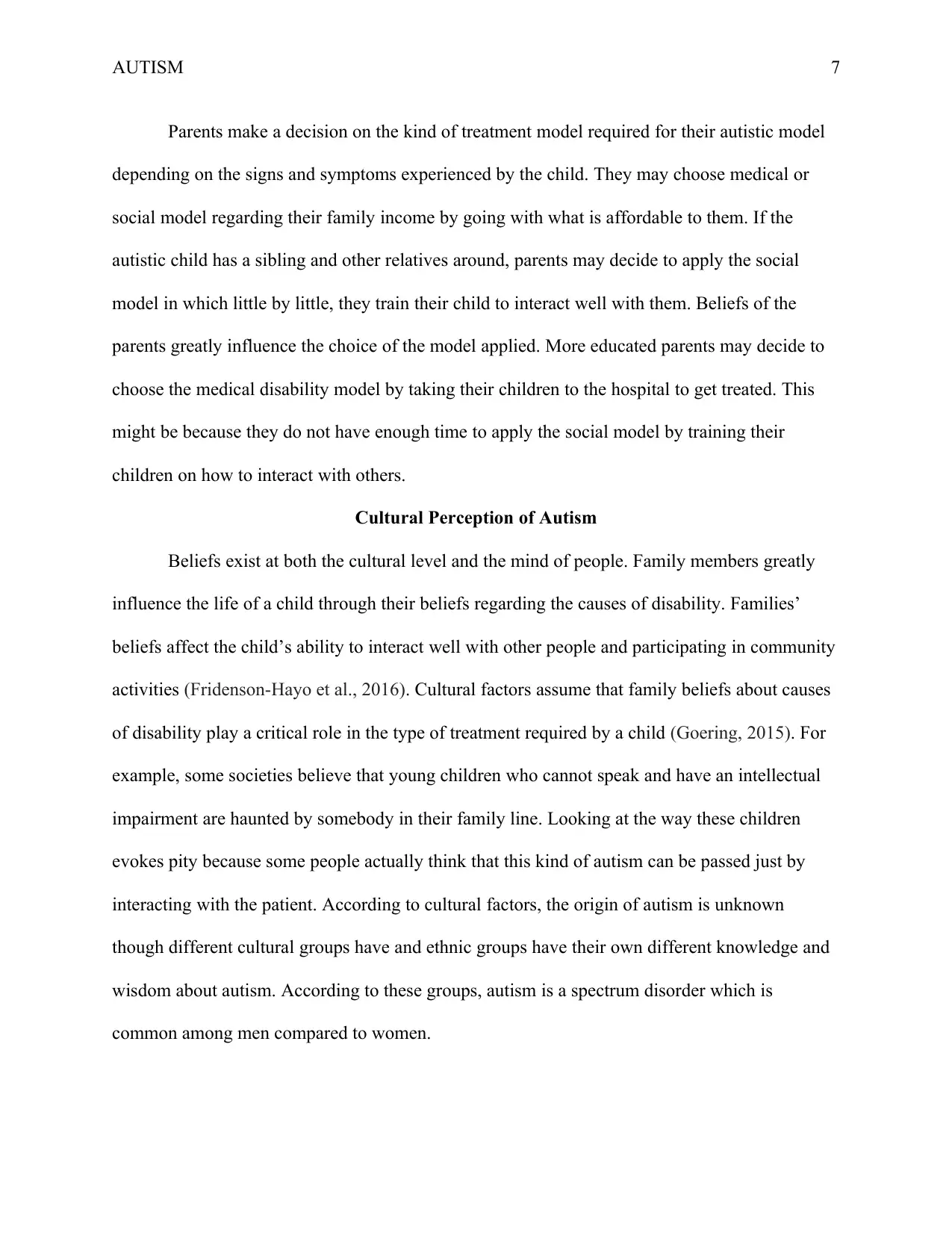
AUTISM 7
Parents make a decision on the kind of treatment model required for their autistic model
depending on the signs and symptoms experienced by the child. They may choose medical or
social model regarding their family income by going with what is affordable to them. If the
autistic child has a sibling and other relatives around, parents may decide to apply the social
model in which little by little, they train their child to interact well with them. Beliefs of the
parents greatly influence the choice of the model applied. More educated parents may decide to
choose the medical disability model by taking their children to the hospital to get treated. This
might be because they do not have enough time to apply the social model by training their
children on how to interact with others.
Cultural Perception of Autism
Beliefs exist at both the cultural level and the mind of people. Family members greatly
influence the life of a child through their beliefs regarding the causes of disability. Families’
beliefs affect the child’s ability to interact well with other people and participating in community
activities (Fridenson-Hayo et al., 2016). Cultural factors assume that family beliefs about causes
of disability play a critical role in the type of treatment required by a child (Goering, 2015). For
example, some societies believe that young children who cannot speak and have an intellectual
impairment are haunted by somebody in their family line. Looking at the way these children
evokes pity because some people actually think that this kind of autism can be passed just by
interacting with the patient. According to cultural factors, the origin of autism is unknown
though different cultural groups have and ethnic groups have their own different knowledge and
wisdom about autism. According to these groups, autism is a spectrum disorder which is
common among men compared to women.
Parents make a decision on the kind of treatment model required for their autistic model
depending on the signs and symptoms experienced by the child. They may choose medical or
social model regarding their family income by going with what is affordable to them. If the
autistic child has a sibling and other relatives around, parents may decide to apply the social
model in which little by little, they train their child to interact well with them. Beliefs of the
parents greatly influence the choice of the model applied. More educated parents may decide to
choose the medical disability model by taking their children to the hospital to get treated. This
might be because they do not have enough time to apply the social model by training their
children on how to interact with others.
Cultural Perception of Autism
Beliefs exist at both the cultural level and the mind of people. Family members greatly
influence the life of a child through their beliefs regarding the causes of disability. Families’
beliefs affect the child’s ability to interact well with other people and participating in community
activities (Fridenson-Hayo et al., 2016). Cultural factors assume that family beliefs about causes
of disability play a critical role in the type of treatment required by a child (Goering, 2015). For
example, some societies believe that young children who cannot speak and have an intellectual
impairment are haunted by somebody in their family line. Looking at the way these children
evokes pity because some people actually think that this kind of autism can be passed just by
interacting with the patient. According to cultural factors, the origin of autism is unknown
though different cultural groups have and ethnic groups have their own different knowledge and
wisdom about autism. According to these groups, autism is a spectrum disorder which is
common among men compared to women.
Paraphrase This Document
Need a fresh take? Get an instant paraphrase of this document with our AI Paraphraser
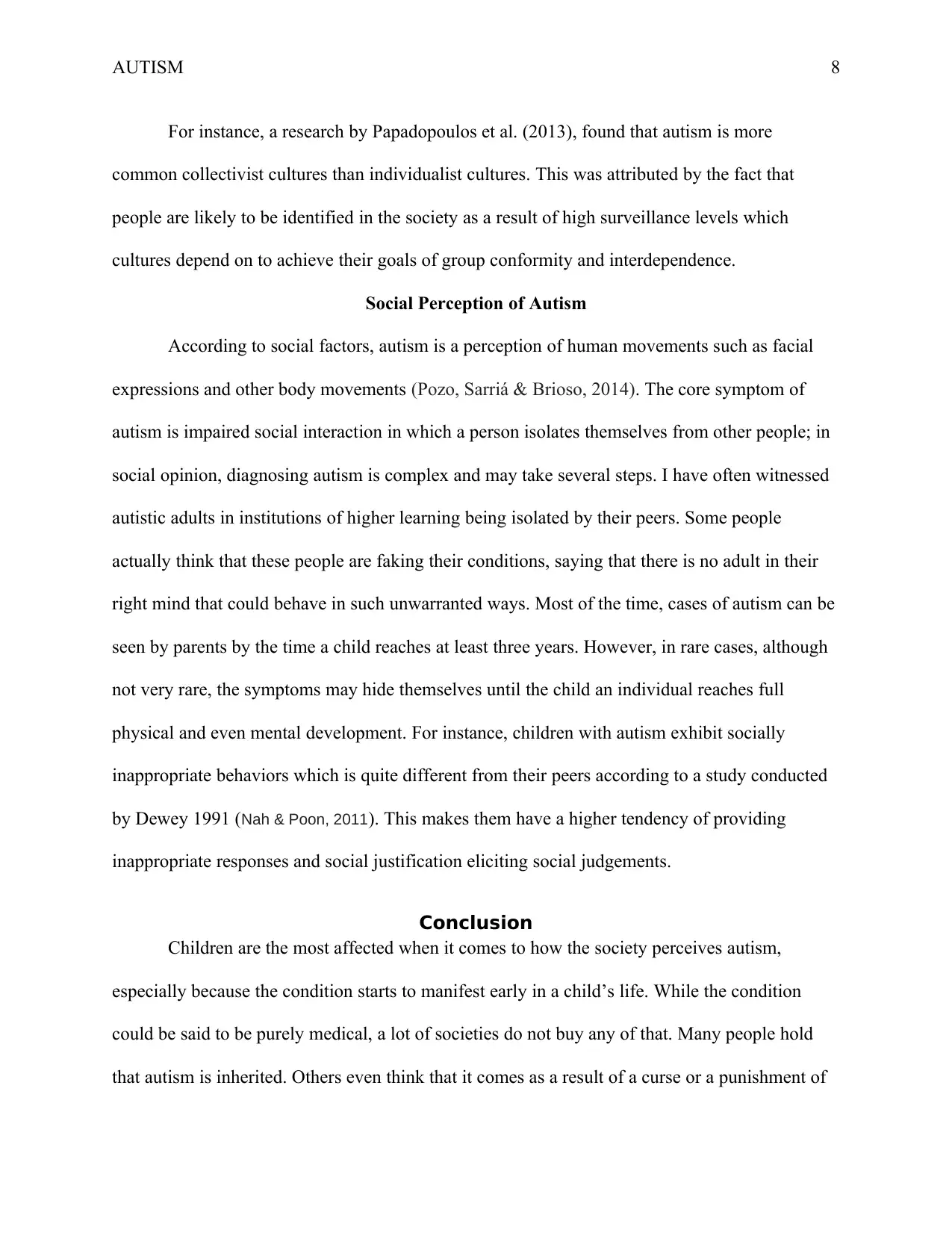
AUTISM 8
For instance, a research by Papadopoulos et al. (2013), found that autism is more
common collectivist cultures than individualist cultures. This was attributed by the fact that
people are likely to be identified in the society as a result of high surveillance levels which
cultures depend on to achieve their goals of group conformity and interdependence.
Social Perception of Autism
According to social factors, autism is a perception of human movements such as facial
expressions and other body movements (Pozo, Sarriá & Brioso, 2014). The core symptom of
autism is impaired social interaction in which a person isolates themselves from other people; in
social opinion, diagnosing autism is complex and may take several steps. I have often witnessed
autistic adults in institutions of higher learning being isolated by their peers. Some people
actually think that these people are faking their conditions, saying that there is no adult in their
right mind that could behave in such unwarranted ways. Most of the time, cases of autism can be
seen by parents by the time a child reaches at least three years. However, in rare cases, although
not very rare, the symptoms may hide themselves until the child an individual reaches full
physical and even mental development. For instance, children with autism exhibit socially
inappropriate behaviors which is quite different from their peers according to a study conducted
by Dewey 1991 (Nah & Poon, 2011). This makes them have a higher tendency of providing
inappropriate responses and social justification eliciting social judgements.
Conclusion
Children are the most affected when it comes to how the society perceives autism,
especially because the condition starts to manifest early in a child’s life. While the condition
could be said to be purely medical, a lot of societies do not buy any of that. Many people hold
that autism is inherited. Others even think that it comes as a result of a curse or a punishment of
For instance, a research by Papadopoulos et al. (2013), found that autism is more
common collectivist cultures than individualist cultures. This was attributed by the fact that
people are likely to be identified in the society as a result of high surveillance levels which
cultures depend on to achieve their goals of group conformity and interdependence.
Social Perception of Autism
According to social factors, autism is a perception of human movements such as facial
expressions and other body movements (Pozo, Sarriá & Brioso, 2014). The core symptom of
autism is impaired social interaction in which a person isolates themselves from other people; in
social opinion, diagnosing autism is complex and may take several steps. I have often witnessed
autistic adults in institutions of higher learning being isolated by their peers. Some people
actually think that these people are faking their conditions, saying that there is no adult in their
right mind that could behave in such unwarranted ways. Most of the time, cases of autism can be
seen by parents by the time a child reaches at least three years. However, in rare cases, although
not very rare, the symptoms may hide themselves until the child an individual reaches full
physical and even mental development. For instance, children with autism exhibit socially
inappropriate behaviors which is quite different from their peers according to a study conducted
by Dewey 1991 (Nah & Poon, 2011). This makes them have a higher tendency of providing
inappropriate responses and social justification eliciting social judgements.
Conclusion
Children are the most affected when it comes to how the society perceives autism,
especially because the condition starts to manifest early in a child’s life. While the condition
could be said to be purely medical, a lot of societies do not buy any of that. Many people hold
that autism is inherited. Others even think that it comes as a result of a curse or a punishment of
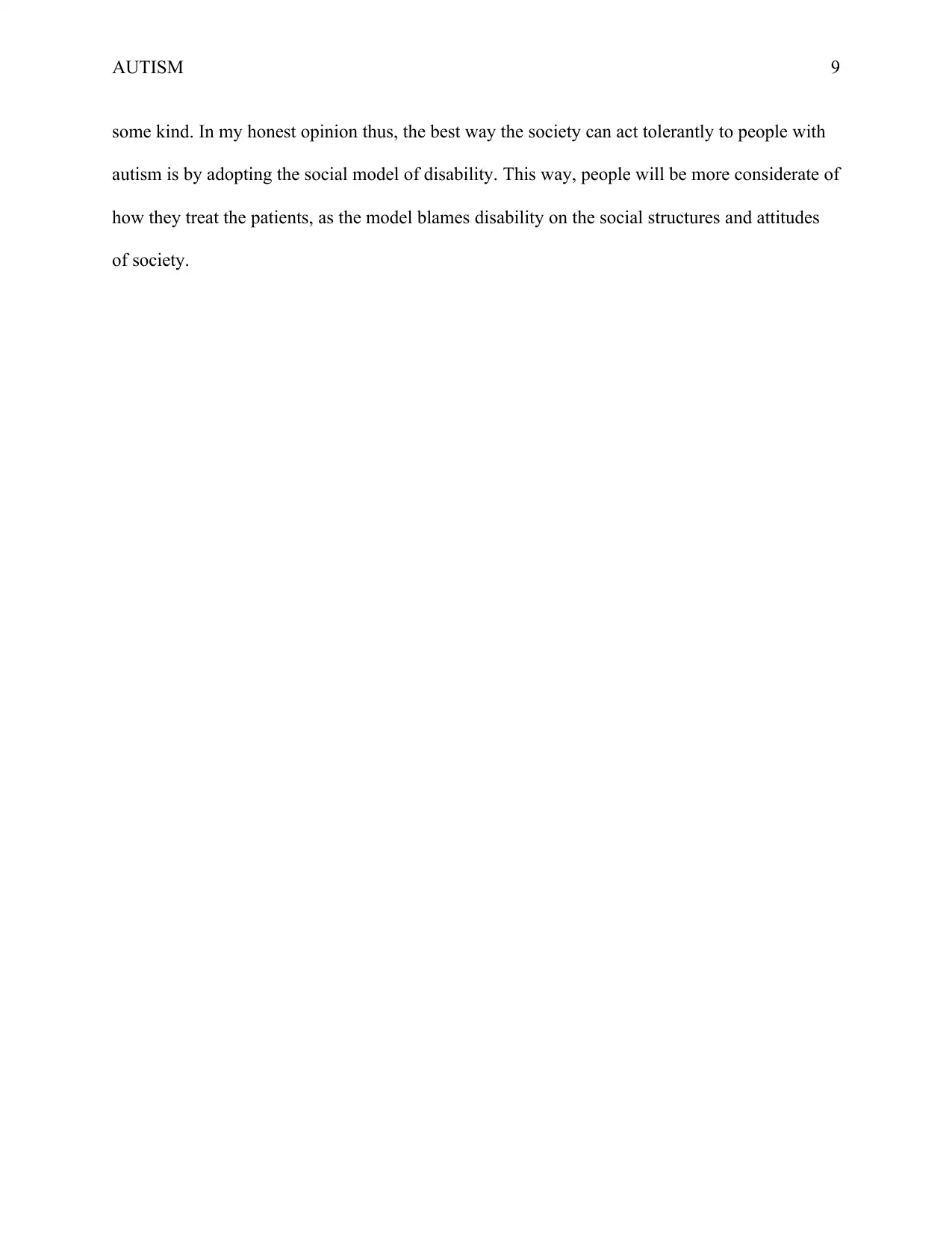
AUTISM 9
some kind. In my honest opinion thus, the best way the society can act tolerantly to people with
autism is by adopting the social model of disability. This way, people will be more considerate of
how they treat the patients, as the model blames disability on the social structures and attitudes
of society.
some kind. In my honest opinion thus, the best way the society can act tolerantly to people with
autism is by adopting the social model of disability. This way, people will be more considerate of
how they treat the patients, as the model blames disability on the social structures and attitudes
of society.
⊘ This is a preview!⊘
Do you want full access?
Subscribe today to unlock all pages.

Trusted by 1+ million students worldwide
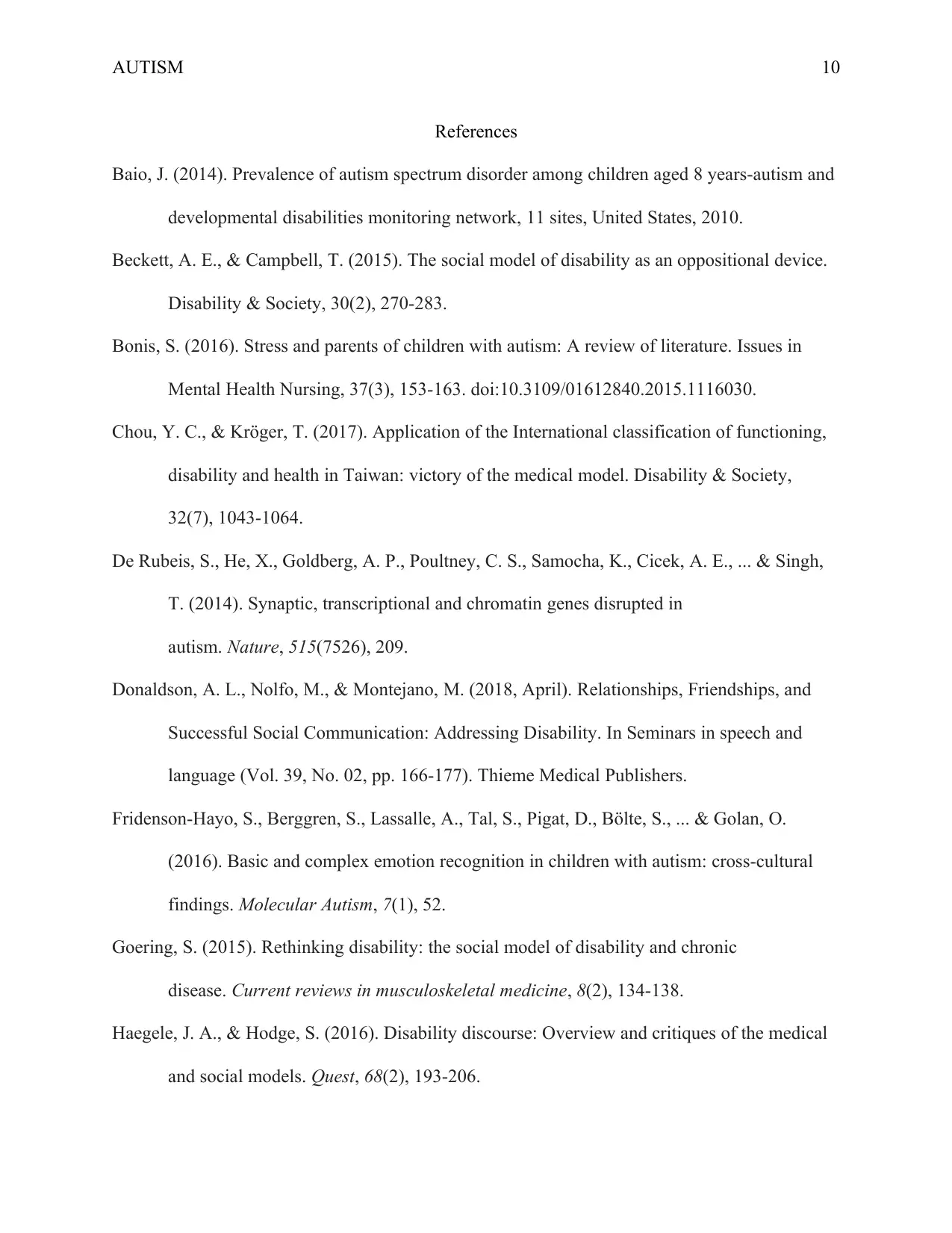
AUTISM 10
References
Baio, J. (2014). Prevalence of autism spectrum disorder among children aged 8 years-autism and
developmental disabilities monitoring network, 11 sites, United States, 2010.
Beckett, A. E., & Campbell, T. (2015). The social model of disability as an oppositional device.
Disability & Society, 30(2), 270-283.
Bonis, S. (2016). Stress and parents of children with autism: A review of literature. Issues in
Mental Health Nursing, 37(3), 153-163. doi:10.3109/01612840.2015.1116030.
Chou, Y. C., & Kröger, T. (2017). Application of the International classification of functioning,
disability and health in Taiwan: victory of the medical model. Disability & Society,
32(7), 1043-1064.
De Rubeis, S., He, X., Goldberg, A. P., Poultney, C. S., Samocha, K., Cicek, A. E., ... & Singh,
T. (2014). Synaptic, transcriptional and chromatin genes disrupted in
autism. Nature, 515(7526), 209.
Donaldson, A. L., Nolfo, M., & Montejano, M. (2018, April). Relationships, Friendships, and
Successful Social Communication: Addressing Disability. In Seminars in speech and
language (Vol. 39, No. 02, pp. 166-177). Thieme Medical Publishers.
Fridenson-Hayo, S., Berggren, S., Lassalle, A., Tal, S., Pigat, D., Bölte, S., ... & Golan, O.
(2016). Basic and complex emotion recognition in children with autism: cross-cultural
findings. Molecular Autism, 7(1), 52.
Goering, S. (2015). Rethinking disability: the social model of disability and chronic
disease. Current reviews in musculoskeletal medicine, 8(2), 134-138.
Haegele, J. A., & Hodge, S. (2016). Disability discourse: Overview and critiques of the medical
and social models. Quest, 68(2), 193-206.
References
Baio, J. (2014). Prevalence of autism spectrum disorder among children aged 8 years-autism and
developmental disabilities monitoring network, 11 sites, United States, 2010.
Beckett, A. E., & Campbell, T. (2015). The social model of disability as an oppositional device.
Disability & Society, 30(2), 270-283.
Bonis, S. (2016). Stress and parents of children with autism: A review of literature. Issues in
Mental Health Nursing, 37(3), 153-163. doi:10.3109/01612840.2015.1116030.
Chou, Y. C., & Kröger, T. (2017). Application of the International classification of functioning,
disability and health in Taiwan: victory of the medical model. Disability & Society,
32(7), 1043-1064.
De Rubeis, S., He, X., Goldberg, A. P., Poultney, C. S., Samocha, K., Cicek, A. E., ... & Singh,
T. (2014). Synaptic, transcriptional and chromatin genes disrupted in
autism. Nature, 515(7526), 209.
Donaldson, A. L., Nolfo, M., & Montejano, M. (2018, April). Relationships, Friendships, and
Successful Social Communication: Addressing Disability. In Seminars in speech and
language (Vol. 39, No. 02, pp. 166-177). Thieme Medical Publishers.
Fridenson-Hayo, S., Berggren, S., Lassalle, A., Tal, S., Pigat, D., Bölte, S., ... & Golan, O.
(2016). Basic and complex emotion recognition in children with autism: cross-cultural
findings. Molecular Autism, 7(1), 52.
Goering, S. (2015). Rethinking disability: the social model of disability and chronic
disease. Current reviews in musculoskeletal medicine, 8(2), 134-138.
Haegele, J. A., & Hodge, S. (2016). Disability discourse: Overview and critiques of the medical
and social models. Quest, 68(2), 193-206.
Paraphrase This Document
Need a fresh take? Get an instant paraphrase of this document with our AI Paraphraser
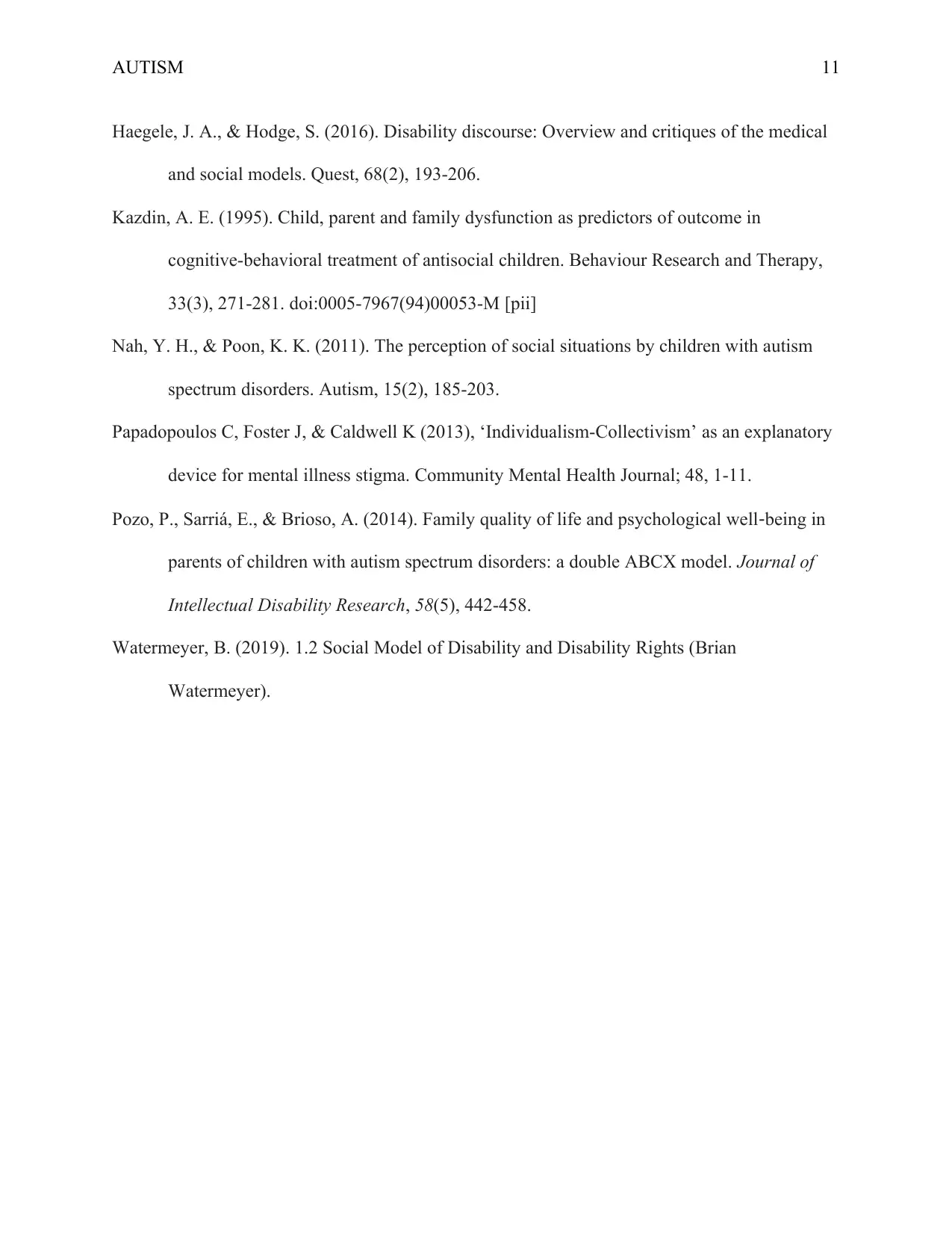
AUTISM 11
Haegele, J. A., & Hodge, S. (2016). Disability discourse: Overview and critiques of the medical
and social models. Quest, 68(2), 193-206.
Kazdin, A. E. (1995). Child, parent and family dysfunction as predictors of outcome in
cognitive-behavioral treatment of antisocial children. Behaviour Research and Therapy,
33(3), 271-281. doi:0005-7967(94)00053-M [pii]
Nah, Y. H., & Poon, K. K. (2011). The perception of social situations by children with autism
spectrum disorders. Autism, 15(2), 185-203.
Papadopoulos C, Foster J, & Caldwell K (2013), ‘Individualism-Collectivism’ as an explanatory
device for mental illness stigma. Community Mental Health Journal; 48, 1-11.
Pozo, P., Sarriá, E., & Brioso, A. (2014). Family quality of life and psychological well‐being in
parents of children with autism spectrum disorders: a double ABCX model. Journal of
Intellectual Disability Research, 58(5), 442-458.
Watermeyer, B. (2019). 1.2 Social Model of Disability and Disability Rights (Brian
Watermeyer).
Haegele, J. A., & Hodge, S. (2016). Disability discourse: Overview and critiques of the medical
and social models. Quest, 68(2), 193-206.
Kazdin, A. E. (1995). Child, parent and family dysfunction as predictors of outcome in
cognitive-behavioral treatment of antisocial children. Behaviour Research and Therapy,
33(3), 271-281. doi:0005-7967(94)00053-M [pii]
Nah, Y. H., & Poon, K. K. (2011). The perception of social situations by children with autism
spectrum disorders. Autism, 15(2), 185-203.
Papadopoulos C, Foster J, & Caldwell K (2013), ‘Individualism-Collectivism’ as an explanatory
device for mental illness stigma. Community Mental Health Journal; 48, 1-11.
Pozo, P., Sarriá, E., & Brioso, A. (2014). Family quality of life and psychological well‐being in
parents of children with autism spectrum disorders: a double ABCX model. Journal of
Intellectual Disability Research, 58(5), 442-458.
Watermeyer, B. (2019). 1.2 Social Model of Disability and Disability Rights (Brian
Watermeyer).
1 out of 11
Related Documents
Your All-in-One AI-Powered Toolkit for Academic Success.
+13062052269
info@desklib.com
Available 24*7 on WhatsApp / Email
![[object Object]](/_next/static/media/star-bottom.7253800d.svg)
Unlock your academic potential
Copyright © 2020–2025 A2Z Services. All Rights Reserved. Developed and managed by ZUCOL.





